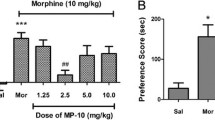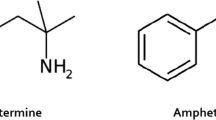Abstract
Rationale
Dopamine may produce reward-related learning by activating D1-like receptors in the nucleus accumbens (NAc) and stimulating the formation of cyclic adenosine monophosphate (cAMP) and the activation of cAMP-dependent protein kinase (PKA).
Objectives
This hypothesis was tested using the conditioned place preference (CPP) based on NAc injections of amphetamine (amph) and evaluating the effects of PKA inhibition with Rp-cAMPS.
Methods
The CPP procedure consisted of three phases: pre-exposure (three 15-min sessions in a chamber consisting of two distinct compartments connected by a tunnel), conditioning (four 30-min placements into one compartment with the tunnel blocked following drug injection into the NAc alternating with four similar placements into the other side following NAc injection of saline), and test (one 15-min session with the tunnel open). A CPP was defined as an increase in time spent on the drug-paired side from mean pre-exposure to test.
Results
Dose-response experiments showed that 15.0 or 20.0 but not 5.0 or 10.0 µg/0.5 µl per side of amph produced a CPP. The amph (20.0 µg) CPP was blocked by Rp-cAMPS co-injections of 25.0 and 250 but not 2.5 ng/0.5 µl per side. Rp-cAMPS or the PKA activator Sp-cAMPS (50.0, 250, 500, 600 ng/0.5 µl per side) alone had no effect on side preference. Co-injection of 10.0 µg amph+Sp-cAMPS (25.0, 50.0, 250, 500 ng) did not result in a CPP but co-injection of 20.0 µg amph+Sp-cAMPS (250 ng) led to a loss of the CPP normally seen with that dose of amph. Doses of Rp-cAMPS that blocked CPP did not block the locomotor stimulatory effect of amph during conditioning sessions.
Conclusions
Results supported the hypothesis that PKA activation in NAc is necessary for reward-related learning.



Similar content being viewed by others
References
Abrahams BS, Rutherford JD, Mallet PE, Beninger RJ (1998) Place conditioning with the dopamine D1-like agonist SKF 82958 but not SKF 81297 or SKF 77434. Eur J Pharmacol 343:111–118
Aujla H, Beninger RJ (2001) Hippocampal-prefrontocortical circuits: PKA inhibition in the PFC impairs delayed non-matching in the radial maze in rats. Behav Neurosci 115:1204–1211
Baldwin AE, Sadeghian K, Holahan R, Kelley AE (2002) Appetitive instrumental learning is impaired by inhibition of cAMP-dependent protein kinase within the nucleus accumbens. Neurobiol Learn Mem 77:44–62
Beninger RJ (1983) The role of dopamine in locomotor activity and learning. Brain Res Rev 6:173–196
Beninger RJ, Miller R (1998) Dopamine D1-like receptors and reward-related incentive learning. Neurosci Biobehav Rev 22:335–345
Berke JD, Hyman SE (2000) Addiction, dopamine, and the molecular mechanisms of memory. Neuron 25:515–536
Blackburn JR, Phillips AG, Jakubovic A, Fibiger HC (1986) Increased dopamine metabolism in the nucleus accumbens and striatum following consumption of a nutritive meal but not a palatable non-nutritive saccharin solution. Pharmacol Biochem Behav 25:1095–1100
Brockwell NT, Ferguson DS, Beninger RJ (1996) A computerized system for the simultaneous monitoring of place conditioning and locomotor activity in rats. J Neurosci Meth 64:227–232
Carr GD, White NM (1986) Anatomical disassociation of amphetamine's rewarding and aversive effects: an intracranial microinjection study. Psychopharmacology 89:340–346
Di Chiara G (1999) Drug addiction as dopamine-dependent associative learning disorder. Eur J Pharmacol 375:13–30
Elliott R, Friston KL, Dolan RJ (2000) Dissociable neural responses in human reward systems. J Neurosci 20:6156–6165
Fiala A, Muller U, Menzel R (1999) Reversible downregulation of protein kinase a during olfactory learning using antisense technique impairs long-term memory formation in the honeybee, Apis mellifera. J Neurosci 19:10125–10134
Fowler SC, Liou J-R (1994) Microcatalepsy and disruption of forelimb usage during operant behavior: differences between dopamine D1 (SCH-23390) and D2 (raclopride) antagonists. Psychopharmacology 115:24–30
Gramling SE, Fowler SC (1985) Effects of neuroleptics on rate and duration of operant versus reflective licking in rats. Pharmacol Biochem Behav 22:541–546
Horvitz JC (2000) Mesolimbic and nigrostriatal dopamine responses to salient non-reward events. Neuroscience 96:651–656
Izquierdo I, Medina JH, Vianna MRM, Izquierdo LA, Barros DM (1999) Separate mechanisms for short- and long-term memory. Behav Brain Res 103:1–12
Jentsch JD, Olausson P, Nestler EJ, Taylor JR (2002) Stimulation of Protein kinase A activity in the rat amygdala enhances reward-related learning. Biol Psychiatry 52:111–118
Joseph MH, Hodges H, Gray JA (1989) Lever pressing for food reward and in vivo voltammetry: evidence for increases in extracellular homovanillic acid, the dopamine metabolite, and uric acid in the rat caudate nucleus. Neuroscience 32:195–201
Kandel ER (2001) The molecular biology of memory storage: a dialogue between genes and synapses. Science 294:1030–1038
Kiyatkin EA (1995) Functional significance of mesolimbic dopamine. Neurosci Biobehav Rev 19:573–598
Knutson B, Adams CM, Fong GW, Hommer D (2001) Anticipation of increasing monetary reward selectively recruits nucleus accumbens. J Neurosci 21:RC159 1–RC159 5
Paxinos G, Watson C (1998) The rat brain in stereotaxic coordinates, 4th edn. Academic Press, San Diego
Pfaus TG, Phillips AG (1991) Role of dopamine in anticipatory and consummatory aspects of sexual behavior in the male rat. Behav Neurosci 105:727–720
Pickens R, Harris WC (1968) Self-administration of d-amphetamine by rats. Psychopharmacology 12:158–163
Pickens R, Thompson T (1968) Cocaine reinforced behavior in rats: effects of reinforcement magnitude and fixed ration size. J Pharmacol Exp Ther 161:122–129
Rose SPR (2000) God's organism? The chick as a model system for memory studies. Learn Mem 7:1–17
Schafe GE, Le Doux JE (2000) Memory consolidation of auditory Pavlovian fear conditioning requires protein synthesis and protein kinase A in the amygdala. J Neurosci 20:RC96:1–5
Scheel-Krüger J (1971) Comparative studies of various amphetamine analogues demonstrating different interactions with the metabolism of the catecholamines in the brain. Eur J Pharmacol 14:47–59
Schultz W (2000) Multiple reward signals in the brain. Nat Rev Neurosci 1:199–208
Schultz W, Dayan P, Montague PR (1997) A neural substrate of prediction and reward. Science 275:1593–1599
Self DW, Belluzzi JD, Kossuth S, Stein L (1996) Self-administration of the D1 agonist SKF 82958 is mediated by D1, not D2, receptors. Psychopharmacology 123:303–306
Self DW, Genova LM, Hope BT, Barnhart WJ, Spencer JJ, Nestler EJ (1998) Involvement of cAMP-dependent protein kinase in the nucleus accumbens in cocaine self-administration and relapse of cocaine-seeking behavior. J Neurosci 18:1848–1859
Sheng M, Kim MJ (2002) Postsynaptic signaling and plasticity mechanisms. Science 298:776–780
Sutton MA, McGibney K, Beninger RJ (2000) Inhibition of protein kinase A in the nucleus accumbens: dissociable effects on unconditioned activity, locomotor sensitization, and conditioned activity produced by intra-accumbens amphetamine. Behav Pharmacol 11:365–376
Taylor JR, Birnbaum S, Ubriani R, Arnsten AFT (1999) Activation of cAMP-dependent protein kinase A in prefrontal cortex impairs working memory performance. J Neurosci 19: RC23 1–5
Tzschentke TM (1998) Measuring reward with the conditioned place preference paradigm: a comprehensive review of drug effects, recent progress and new issues. Prog Neurobiol 56:613–672
Waddell S, Quinn WG (2001) Flies, genes and learning. Annu Rev Neurosci 24:1283–1309
Westerink BHC (1979) The effects of drugs on dopamine biosynthesis and metabolism in the brain. In: Horn AS, Korf J, Westerink BHC (eds) The neurobiology of dopamine. Academic Press, London, pp 255–291
Wise RA, Spindler J, de Wit H, Gerber GJ (1978) Neuroleptic-induced "anhedonia" in rats: pimozide blocks reward quality of food. Science 201:262–264
Acknowledgements
This study was funded by a grant from the Natural Sciences and Engineering Research Council of Canada to R.J.B.
Author information
Authors and Affiliations
Corresponding author
Rights and permissions
About this article
Cite this article
Beninger, R.J., Nakonechny, P.L. & Savina, I. cAMP-dependent protein kinase and reward-related learning: intra-accumbens Rp-cAMPS blocks amphetamine-produced place conditioning in rats. Psychopharmacology 170, 23–32 (2003). https://doi.org/10.1007/s00213-003-1510-2
Received:
Accepted:
Published:
Issue Date:
DOI: https://doi.org/10.1007/s00213-003-1510-2




